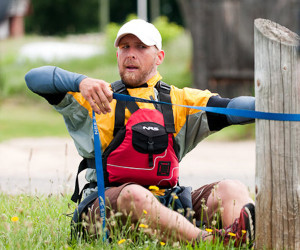
For many years, kayaking has been one of the fastest-growing segments of the outdoor industry. No surprise there; kayaking is easy to get started with, fun right from the get-go, and, once you have the necessary gear, it’s a very low-cost, low-environmental-impact sport. It’s no secret that most of us here at EasternSlopes.com are kayak enthusiasts. Most of us own one (or more) kayaks and paddle them often. But none of us are “Experts.”
At the 2012 New England Paddle Sports Show in Durham, New Hampshire (which is put on by Kittery Trading Post each year in late March or early April), EasternSlopes.com’s Executive Editor Tim Jones attended a seminar called “Selecting The Perfect Kayak Paddle”. This was presented by Danny Mongno, a kayak fanatic, paddling instructor and all-around bundle of energy and enthusiasm who also happens to work for Werner Paddles as a “Regional Sales Manager,” and “Field Marketing Coordinator” (which we guess means he gets to paddle a lot). Impressively, however, Mongno never mentioned Werner paddles until the seminar was almost over. Instead, he jumped from floor to chair to table top to blackboard as he diagrammed and demonstrated how to hold a paddle, different styles of paddle strokes and how the correct paddle, matched to paddler, paddling style, and boat, improves paddling efficiency and allows the paddler to have more fun with each on-water adventure. It was an engaging, informative hour.

After the seminar, Jones caught up with Mongno and got him to hold still (no easy task) long enough to outline and expand on the essential points covered in his seminar. Here then, are some thoughts from a real expert.
Choosing the Right Kayak Paddle: How To Select The Perfect Paddle For You!
ES: First of all, Danny, let’s answer the basic question: Any paddle will move a kayak through the water, why spend so much time and money looking for the “right” one?
Mongno: Choosing the right kayak paddle among all the kayak paddles out there is probably the most important decision you will make as a boater. The paddle is the tool that transfers your energy to the water and, ultimately, to moving your boat. Choosing the proper blade shape will allow you to perform at the highest level for your body and your boat. A paddle that fits perfectly will allow you to be more comfortable, use less energy and spend more time on the water. Although it is such an important decision, it does not have to be hard.
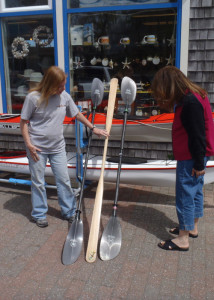
ES: OK, So where do you start?
Mongno: It really takes only a few simple steps to fit you with the perfect kayak paddle. You begin by choosing the right blade shape for your style of paddling.
ES: Whoa, stop right there. We aren’t all kayak fanatics. What do you mean by “style of paddling”?
Mongno: Basically, if you are paddling correctly, most of your paddling power comes from the big muscles in your torso as you twist your upper body, not from your arms pulling the paddle through the water. But the position of your arms determines how the power in those muscles gets transferred to the water and, ultimately, to moving the boat. Most recreational paddlers (not racers) paddle either “low angle” or “high angle.” The “angle,” in this case, is the angle of the paddle shaft relative to the horizontal surface of the water. That angle is determined by the upper hand on the paddle and where it positions in relation to your body.
ES: What are the advantages and disadvantages of “low angle” paddling?

Mongno: Most people start out with low angle paddling, which keeps your top hand at about shoulder height through each paddle stroke. A low-angle style allows paddlers to still use good torso-rotation paddling technique and focus on using core strength rather than arms strength, but it’s also more relaxing, which allows you more time on the water just having fun. With your hands in a low-angle position, you put significantly less pressure on your upper body, arms and shoulders. For low-angle paddlers, a longer, narrower blade shape, “fits” in the water better and presents more surface area to the water for more paddling efficiency.
ES: If low-angle paddling is both relaxing and efficient, why would anyone ever choose “high angle”?

Mongno: High angle paddling requires more commitment to technique, but it’s more efficient. You move the boat farther in the direction you want to go with each stroke. In high angle paddling, your top hand stays at about forehead height as you take your stroke. The first thing you will notice is that the blade travels closer to the kayak. With the blade traveling in this path your boat will track significantly straighter—you won’t see the bow moving left or right of your intended line with each stroke. Now this style does place more emphasis on proper torso rotation since more pressure can be put on your shoulders. So you have to learn proper technique. The commitment is worth it though for those looking to take their paddling to a higher performance level, especially in longer, sleeker light touring and touring kayaks. For high angle paddling, a wider, shorter blade shape puts more surface area of the blade into the water.
ES: What do you do if you can’t decide or don’t yet know what style of paddling you prefer?
Mongno: Ask yourself “What do you see yourself doing the most out there?” Do you want to paddle long distances? Do you want to go fast? Do you want to just relax and not think about it? Look at the boat you are paddling and your goals in the sport and then buy the blade that works best for that application.
If you are in a wider boat, just relaxing on the water, think low angle. But that longer, narrower blade is more likely to “flutter” if you dig it deep into the water in a high-angle style. If you want to travel faster, farther in a high-performance boat, think high angle. But remember, unless you use proper technique, that wider, shorter blade is going to put more pressure on your wrists, arms and shoulders than the longer, narrower blade of a low-angle paddle, and probably tire you out quicker. Just remember the proper blade shape is going to offer you maximum performance in whatever paddling style you choose.
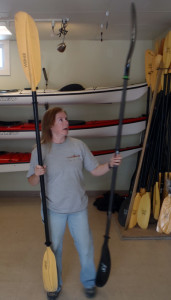
ES: What about blade size?
Mongno: This is really common sense and easily determined by your body size. Smaller people would look towards a medium or smaller blade surface area to put less stress and strain on the body. Larger boaters, generally go with a medium- to full-sized blade depending on their fitness level. Remember, a bigger blade is not always going to make you more powerful, especially if you are working too hard to move that extra blade area through the water.
ES: Okay, what next?
Mongno: Once you have the proper blade shape and size for you and your paddling style the next step is getting the right fit. Perfect fit will assure comfort and the least amount of energy used with each paddle stroke on the water.
The first choice you are going to make is length, and here are some easy-to-follow rules:
For low-angle paddling, if you are 6 feet tall or less, choose a 220cm. paddle; if you are taller than 6 feet, choose 230cm. And if your kayak is over 28” wide, add 10cm to the length of the paddle.
For high-angle paddling, if you are 6 feet tall or less, choose a 210cm paddle; if you are taller than 6 feet, choose 215cm. Kayak width generally does not come into play here since most high-angle paddlers are in narrow, light touring and touring kayaks.
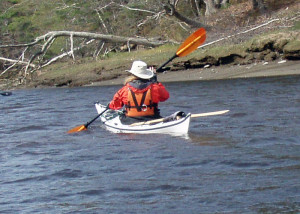
ES: What’s the penalty if you choose a paddle that’s too long or too short?
Mongno: Well, you should be able to purchase the right paddle by sticking to the simple formula I gave you for low angle and high angle length based primarily on your height. However, let’s say you borrowed a random paddle and it is the wrong fit. For low-angle paddling, too long a paddle is going to seriously affect your tracking. Essentially, you’ll be making a mini sweep-stroke with each paddlestroke as the blade moves in a long arc out and away from the boat, which will make it difficult to paddle in a straight line. With each stroke, you’ll waste energy moving your boat in the wrong direction and constantly correcting. That’s not efficient.
Low-angle paddling with too short a paddle means you are always going to be reaching for the water. You’ll feel tippy, keep hitting the side of the boat with your paddle or your hand, and you won’t be able to submerge the entire blade so you lose energy with each stroke and your paddling efficiency will suffer.
With high-angle, a paddle that’s too long means your top hand is too far over the top of your head and you can’t generate as much pushing power with the top hand. Too short and you lose catch length, you need to paddle like a windmill to keep up.
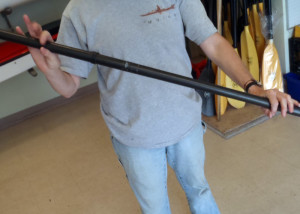
ES: What about shaft options? It seems there are lots of choices.
Mongno: The two basic choices are straight shaft or bent shaft. One benefit of a straight shaft is the familiar feel. We have all used straight shaft at some time and it is what most of us are used to. Other benefits are lighter weight and lower cost. If good technique is used and a paddler holds the paddle loosely with relaxed hands (grasping the shaft with the “O-Kay” symbol—using just the thumb and forefinger and keeping the other fingers relaxed), most people can paddle all day pain free.
But some of us have developed some aches and pains in hands and wrists through age and overuse. And some people feel more comfortable with a tight grip on the paddle (let’s face it, we all do that when we get nervous in wavy and windy conditions). In those case, a “neutral bent shaft” becomes an insurance policy for your body. The bent shaft always keeps the wrists in an ergonomically correct, straight alignment, putting less pressure on the small tendons and ligaments of the wrist. You paddle farther and harder with less pain. Although bent-shaft paddles are more expensive, that investment can mean spending more time on the water and having more fun. The “neutral bent” allows for a smooth transition from your old paddle, as your hand position is familiar and exactly the same as it was on your straight shaft. The only thing that changes is that your wrists remain straight while paddling.
ES: Any other choices to be made when it comes to shaft?
Mongno: Proper shaft diameter is determined by hand size: Smaller hands would choose a smaller diameter shaft for a more relaxed grip. Larger boaters, generally with larger hands, prefer the standard diameter shaft. Most people are going to feel more comfortable with a standard diameter shaft.
ES: What about feathering?
Mongno: “Feathering,” which is the angle of one blade of the paddle relative to the other blade is entirely a matter of personal preference. Many modern paddles allow you to almost infinitely vary feather angles quickly and easily, which lets you experiment easily and find what feels exactly right for you and your paddling style.

ES: What about paddle weight?
Mongno: Well, a lot of people seem to want to judge a paddle just by its overall weight. You’ll see them in a paddle shop hefting one paddle in one hand, another in the other. But that really doesn’t tell you much about the paddles on the water. More important is “swing weight.” A paddle that feels lighter as you move it back and forth through the stroke path, will tire you less, allow you to feel fresher as the miles and hours wear on. You can get an idea of a paddle’s swing weight in the store: grasping the paddle with both hands, hold it parallel to the floor, and twist your torso to move the paddle back and forth in an arc that mimics a good paddling stroke. Just make sure you have space and won’t hit anyone or anything. You’ll pretty quickly feel the difference in swing weight among paddles.
ES: What about ferrules?
Mongno: One of the problems with buying a used paddle is that the ferrule, the joint where the two halves of a two-piece paddle join, can get worn so the paddle feels sloppy. You can actually feel movement between the two halves. Shop for a ferrule system that is easy to use and gives your paddle a solid, one-piece feel when you put it together. If the ferrule is designed well, no matter how many times you take your paddle apart and put it back together, it will never wear out.
ES: Any final words of advice on picking a paddle?
Mongno: Remember that, in a kayak paddle as with anything else, you get what you pay for.

A higher-end paddle is generally made of lighter-but stiffer material and will flex less, allowing less water to “escape” from the blade face with each stroke. You’ll waste less energy just moving the paddle and create more forward motion. Some higher end paddles (like Werner’s Performance Core) offer buoyant blades which lift from the water more easily. These will help you brace with more confidence and, for experienced paddlers, make rolling easier.
Spend as much as you can afford on your paddle. Your paddle is your engine. With a better paddle, you will use less energy on the water, paddle farther and faster and perform better with less fatigue. That means you’ll paddle more. Choosing the right kayak paddle is important. Think of a good paddle as an investment you can enjoy for a long time.
Special Thanks
EasternSlopes.com would like to extend a special thanks to Theresa Willette of Coastal Maine Kayak in Kennebunk, Maine for her help with photos for this article (even if it did mean she HAD to go paddling with us on a lovely spring day!). Theresa is an experienced paddler, and exceptional instructor, and a pleasure to paddle with. If you’ve never paddled along the Maine coast (or even if you have . . .), take one of the kayak tours which leave from her shop in the summer. You’ll see some beautiful spots, learn something about kayaking and likely have a wonderful time.


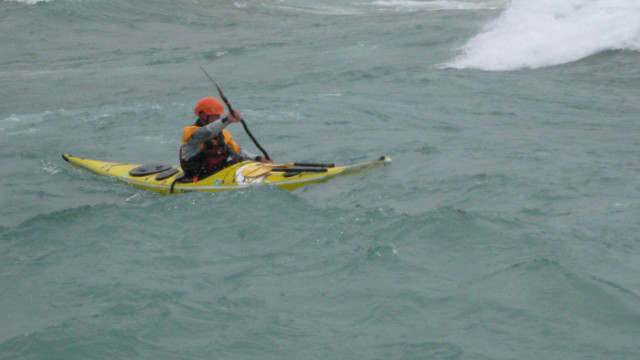
What a great article; so interesting and easy to understand. I wonder, as a low angle paddler, do I need a longer blade?
Thanks for a really good read.
Ed,
Thanks for writing. Glad you liked the story! As Danny Mongno says, your paddle is your engine, and you’ll enjoy paddling more with a good one. The best way to find out if a different paddle will work better for you is to try some out, preferably in a boat you are familiar with. If you are paddling with friends, ask if you can swap paddles around (especially if you think their paddles are better than yours!). Visit your local kayak shop and see if they’ll let you try some paddles on the water, or go to a demo-day event and try every paddle you can get your hands on. Trying new paddles is just another good excuse to get out on the water and have fun.
Great information. This is one of the best articles I have ever read on selecting the right paddle. Thanks again!
I have a graphite paddle which sticks really hard together and at times almost impossible to separate. What do I use to prevent this?
Jan,
I’ve had the same problem with a number of kayak paddles by different manufacturers and I know a number of other people who have, as well. So we asked Danny Mongno of Werner what to do about it. Here’s his reply:
“Typically it’s just debris: pollen residue, sand, salt, etc, that causes the sticking. Washing the ferrule system thoroughly with hot water and bottle brush is the only fix that we suggest. On Werner paddles, at least, the ferrule system is so precise that the smallest amount of foreign matter can cause sticking.”
Danny also recommends contacting the manufacturer if the problem persists after a thorough washing: “If this is a Werner paddle, they should contact us. There are many vintages of Werner paddles, and ferrules have changed. We want to be sure that everyone gets 100% satisfaction from us.”
PS, I’ve always hosed off my paddles whenever I did my boats (after every trip in salt water, for example). But I just took the extra moment to thoroughly wash and scrub two slightly sticky paddles with hot, soapy water and a bottle brush as Danny recommended. Hadn’t realized what a huge difference that little extra care could make!
Taking a fine-grit sandpaper to the inside of your paddle can also help if the bottle brush doesn’t get enough debris out.
Wren,
Thanks for writing.
We checked with Danny Mongno of Werner on the advisability of using sandpaper, and here’s his response:
” “In some circumstances, with other brands or even Werner models dating back to the ’90s and prior, sandpaper may have been a viable option. However as the ferrule system at Werner has advanced, especially post 2002, I would strongly advised against using anything but warm water and some TLC.”
Hope this helps!